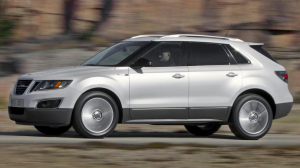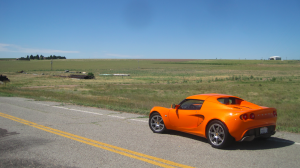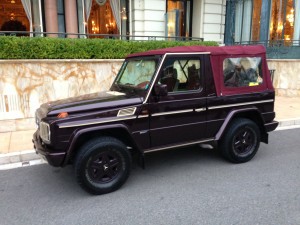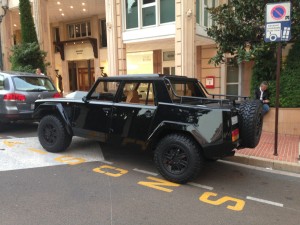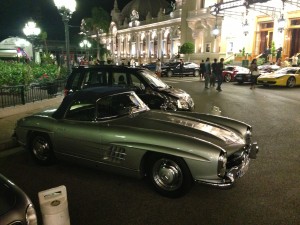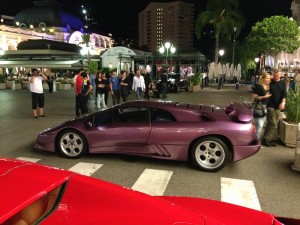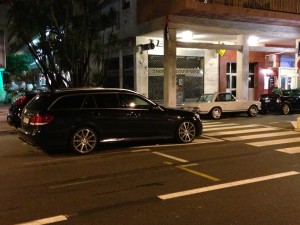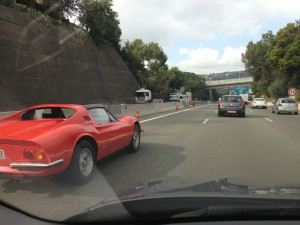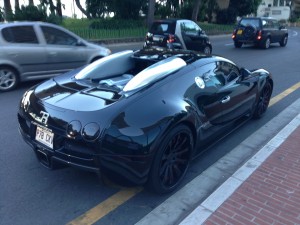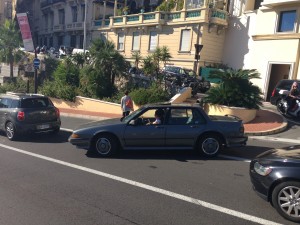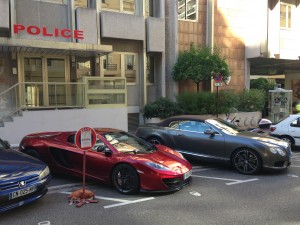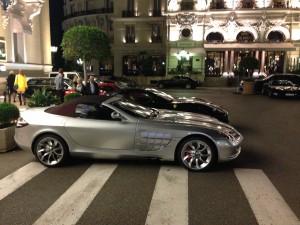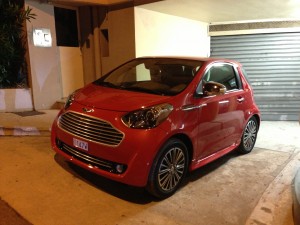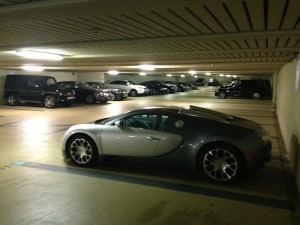Feature: Attention Saab Dealers: It’s Time to Let Go
Posted by Doug DeMuro in Feature on | 0 comments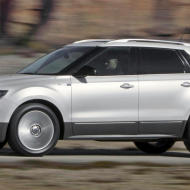
It happened about a week ago. I was sitting in traffic and looking around, as I sometimes do when I’m not texting, and there it was: one of the rarest modern production cars in existence.
For those of you who don’t know which one I’m referring to, a few hints. Think turbocharged power. Think all-wheel drive. Think of a production facility in an exotic, foreign country known for beautiful beaches, expensive resorts, and the occasional tourist beheading.
That’s right, ladies and gentlemen: I’m talking about the Saab 9-4X.
Now, if you’re not sure exactly what a Saab 9-4X is, you aren’t alone. Many people don’t know what a Saab 9-4X is, including most 9-4X owners, because if they did, they probably would’ve bought something else. But if you’re Saably unaware, don’t fret: that’s why you have me, a professional automotive journalist with access to Wikipedia.
It all started in the 1990s when Saab, who, by the way, is born from jets, was sold to General Motors. Eager to transform Saab into a volume brand, GM executed an unusual 15-year plan that involved two distinct steps: first, a decade of doing nothing; then, several years of desperate rebadging. I am told that some GM insiders now question the effectiveness of this strategy.
The 9-4X was the last rebadge, though it did a good job of hiding its Cadillac SRX roots. It had Saab styling, Saab powertrains, and the famous Saab trademark: a center-mounted ignition switch. (NOTE TO OTHER AUTOMAKERS: When your “trademark feature” is the place where drivers stick the key, it’s probably time to gracefully bow out of the car business.)
But the 9-4X was too little, too late. Saab declared bankruptcy before sales took off, and production shut down after 573 units. For perspective, that means the 9-4X would take the “Rarest Vehicle in Attendance” trophy at a car show that also included a Ferrari F40, a Porsche Carrera GT, a Mercedes 300SL, an Aston Martin DB5, and my own Cadillac CTS-V Wagon.
So I was pretty excited when I saw the 9-4X, which meant I went home and did what any car enthusiast would: ignore mounting deadlines in order to spend the afternoon searching AutoTrader.com for used Saabs.
On the used market, the 9-4X fared exactly as you might expect: like the love child of a high-mileage Maybach and one of those early Maseratis where the transmission feels like you’re riding with someone who learned to drive a stick shift over the phone. Think somewhere in the mid-$20,000 range for a 2011 model with reasonable miles, or approximately 30 percent below the mechanically similar Cadillac SRX.
But why buy used when you can buy new?
That’s right, ladies and gentlemen. Here we are, in the fall of 2013, two years after Saab declared bankruptcy, two and a half years after the last Saabs shipped to dealerships, and AutoTrader.com says there are still sixty-five different new 2011 Saabs for sale across the country.
Now, if you’re like me, you’re probably curious about this. You’re probably wondering how they’ve held up after sitting at a dealer for so long. You’re probably wondering what kind of discount you can get. You’re probably wondering when there was ever a tourist beheading in Sweden, or – for that matter – a beautiful beach. (In this case, you’re forgetting that the 9-4X is built in Mexico, where tourist beheading is a common recreational activity, sort of like how in America we have reading.)
But I decided to do more than just wonder. Instead, I played the difficult, dangerous role of an investigative journalist, courageously fighting for you, the consumer. In other words: I actually visited a Saab dealer and looked at the Saabs. Please note it was only a mere coincidence that this was also a Cadillac dealer, and I needed an oil change.
Here’s what I learned.
For one, the cars are holding up just fine. Yeah, so they’re covered in grime, and, in some cases, leaves left over from the fall of 2012. And OK, maybe the window stickers have faded to the point where they’re no longer readable. And sure, the tires are flat-spotted, and the rubber parts have the consistency of pumpkin bread. But you, the interested buyer, can rest easily knowing that absolutely none of this is covered under warranty.
As for the price cut, it’s a big one. A 2011 Saab 9-5 that stickered for $41,000 back in 2011 now sells for roughly $28,000. That means Saab dealers are taking off more than 30 percent, or – as we in the automotive industry call it – “the Mitsubishi discount.”
But even with $13,000 off, you have to wonder precisely who’s going to show up in the parking lot, walk right to the Saabs, and say: I’ll take it!
The answer, in my opinion, is no one. And so, my message to the Saab dealers still holding on to those 65 cars is simple: GIVE UP! It’s been three years. You’ve paid off the cars, plus interest. It’s time to take them to the wholesale auction, run them without a reserve, and be thankful you got anything for them. All of this is assuming, of course, that they’ll start up and drive off the lot. If not, I wish you the best of luck in finding parts. You’re going to need it.
This post originally appeared on Jalopnik.
Feature: I Owned a Lotus Elise For Free, and So Can You!
Posted by Doug DeMuro in Feature on | 1 comment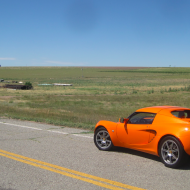
I often get e-mails from readers, people just like you except with more time on their hands, that ask me questions. “Doug,” they might ask, “Should I buy this ’68 Cougar that’s been sitting in a field since the Hartford Whalers were still a hockey team?” That one comes from a muscle car guy. Or “Doug,” another might say, “When are you going to quit this crap and get a real job?” That one comes from my parents.
Well, today I’ve decided to answer a question that I get asked all the time, namely: What’s it like to drive a Lotus Elise? As you may recall, I drove mine across the United States, which is a distance of roughly 3,000 miles or approximately eleven million incredibly uncomfortable highway expansion joints.
Anyway, my answer to this question is: You can find out for yourself. For free.
Now, before I explain how this is possible, I – as usual – know exactly what you’re thinking. And that is: Did you just make a Hartford Whalers reference? No, that’s not it. What you’re really thinking is: Oh my God, now that he’s charmed us with all these columns, he’s going to try to sell us on some Lotus-related multi-level marketing scheme! But I’m here to tell you that’s grossly inaccurate, because let’s be honest, I haven’t charmed you at all.
Plus, I’m not trying to sell you anything. You really can own a Lotus for free, thanks to two simple Lotus-related truths I’ll describe now. They are:
1. Every single Lotus Elise costs $30,000.
OK, so when I said “for free,” there was a slight catch. And the catch is there might be one or two up-front costs that total, say, thirty thousand dollars. But if you have thirty grand to spend on a car, you can buy a Lotus without any fear of losing a penny. Think of it as a mid-engine, open-roof, Toyota-powered savings account.
The reason for this is that every single Lotus Elise costs $30,000. Yes, I’m aware that some newer models are a bit more, as are some special editions. But the bulk of the used Elise market – 2005 and 2006 models – all cost $30,000, almost completely without regard to petty things like mileage, and color, and the fact that the previous owner autocrossed it every weekend since the Bush presidency.
The crazy thing is the $30,000 price floor isn’t a new phenomenon. The Elise cost $30,000 in 2010. They cost $30,000 when I bought mine in 2011. They cost $30,000 when I sold mine in 2012. And a check of average prices on AutoTrader.com reveals they still cost $30,000 today.
The conclusion here is simple: you don’t need to ask me what it’s like to own an Elise. You can buy one, drive it for as long as you like, and not lose a dime. And that’s especially true when you consider…
2. The Lotus Elise costs practically nothing to own.
Here’s the thing about the Elise: it’s really reliable. This may surprise you, considering it comes from the same country as my Range Rover, which, on occasion, drives from one place to another without an electrical fault.
But you have to remember that the Elise is really just a Toyota under its skin. That’s a Toyota engine, a Toyota transmission, and a bunch of Toyota parts, all screwed together by Japanese people who couldn’t possibly fathom the Lotus automotive assembly strategy of: “Eh. Close enough.”
Sure, there are a few Lotus bits in the car. But who needs the power windows to work? I hope you answered “no one,” because you can pretty much expect they won’t work, and if you shut the door hard enough, they’ll shatter in your face.
Anyway: because of all those Toyota parts, the Elise is pretty cheap to fix and reasonable to work on. The downside, of course, is that people in M3s see you in traffic and yell out “NICE CELICA!”
But back to the bit about owning a Lotus for free. For a real world example, let’s return to my Elise, a 2006 model painted in a shade of bright orange called No, Really I Am Cool! Look at Me! Look at Me! Orange Metallic.
Although I can’t quite remember the exact details, I think I bought it for around $30,000, and sold it six months later, after adding 6,500 miles to the odometer, for $29,500. I probably could’ve eeked out a little more, but I was in a real hurry to buy a Mercedes G-Wagen, apparently because the Elise didn’t make me seem like enough of an asshole on the road.
As for ownership costs, my story is a little different than most. Although my only maintenance expense was an oil change, I bought the car from a seller who failed to tell me that the air conditioning wasn’t working. Unfortunately, I didn’t discover this until I was sitting in a pool of my own sweat. In the Mojave Desert. In July. The result was a $1,500 repair bill because, as stated by my Lotus mechanic, “It’s an easy part to change out… once we take off the body.”
So I didn’t technically drive my Elise for free, but you can. Just make sure the air conditioning works before you go driving through the desert. And for God’s sake, don’t spend more than thirty grand. After all, it’s just a nice Celica.
This post originally appeared on Jalopnik.
Feature: In Heavy Traffic, Just Let the Guy Next to You Change Lanes
Posted by Doug DeMuro in Feature on | 1 comment
There’s one distinct advantage of my job compared to, say, your job. And that advantage is: I don’t have to commute. That’s right, ladies and gentlemen. Give up your salaried, safe office job with benefits and room for growth in order to become a writer, and you, too, could spend mornings concerned primarily with why the wireless Internet won’t reach the porch swing.
Of course, I’m not entirely immune to commuting. I spent the last three-and-a-half years of my life working in an office located in the suburbs, which excels in education and lifestyle, whereas I live in the city, which excels in property crime.
The result is that I spent a lot of time commuting, and as I recall it wasn’t a very pleasant experience. I also recall there was a tollbooth along my route, and I constantly got stuck behind the guy who went in the “exact change” lane even though his only form of payment was a personal check.
I’m not always spared from commuting these days, either. I often have to take my girlfriend to the airport, which would be fine, except that she usually schedules flights at around 6:30 p.m. on the day of a baseball game, and a basketball game, and what I can only assume is a global convention for the International Association of Left Lane Cell-Phone Users.
So I’ve done a lot of commuting. And in that time, I’ve realized there are, shall we say, a few flaws with bumper-to-bumper driving etiquette in our great nation. (These flaws also exist in Canada, which is a lot like our great nation except that parts of it have a license plate shaped like a polar bear.) And the biggest flaw is changing lanes.
Allow me to paint you a picture. I’m driving along in bumper-to-bumper traffic, also known as “rush hour,” or, if you live in the Los Angeles area, “always.” I’m not talking about the kind of bumper-to-bumper traffic where you’re rolling along at four miles per hour, and sometimes you get up to, say, nine miles per hour, at which point you excitedly upshift to second gear, only to have your heart sink when you go back down to four because you realize your next car will probably have to be an automatic.
No, I mean stop-and-go bumper-to-bumper traffic. Stop. Go. Stop. Go. You get the idea.
Now, say I’m cruising along in the left lane (Stop. Go.) and I realize my exit is coming up in the next mile, or approximately 90 minutes from now. So what do I do? Being a highly educated driver on account of spending at least one weekend per year in court-ordered traffic school, I put on my turn signal to change lanes. And what does the guy next to me do? He speeds up to block me.
Explain this to me, ladies and gentlemen. We’re doing an average speed of maybe one point seven miles per hour. No one is going anywhere. And yet, instead of letting me over, which would delay his commute by approximately one four-hundredth of a second, the guy next to me actually increases his speed so I can’t get in front of him.
The worst part is that you see this all the time. Some guy, wearing business clothes, lost in thought about that e-mail Johnson sent out at 3 p.m., the one that said there won’t be any more free donuts in the employee break room, suddenly decides he owns this lane God damn it!, a thought which coincidentally strikes him the second you put on your turn signal.
Now, I know what you’re thinking. And that is: Doug, have you considered that people might not let you in because you’re an asshole?
And I must admit, this is certainly a possibility. In fact, I’ve noticed my chances of being let in drop from roughly 50 percent to about 0.7 percent when I’m in my Range Rover instead of my Cadillac, while my chances of being flipped off increase by the opposite amount. Of course, these numbers aren’t scientific, because the Cadillac’s turn signals are so bright and annoying that people will generally do anything to make them stop.
But more often than not, I think people just need a massive lesson in bumper-to-bumper etiquette. So my advice to you is this: if you’re in bumper-to-bumper traffic, for God’s sake, let the other driver change lanes when he puts on his turn signal. Even if he’s in a Range Rover. I know this might be hard for some of you, but there is a silver lining: you can still flip him off.
This post originally appeared on Jalopnik.
Feature: I Got My Ass Kicked Racing a Carrera GT On a Runway [VIDEO!]
Posted by Doug DeMuro in Feature on | 0 comments![Feature: I Got My Ass Kicked Racing a Carrera GT On a Runway [VIDEO!]](http://playswithcars.com/wp-content/uploads/2013/10/Screen-Shot-2013-10-09-at-2.57.30-PM-744631_190x190.png)
I recently spent some time driving on an airport runway. No, I didn’t do this because I’m an old person who ran through a barricade, which is how a Cadillac usually ends up on a runway. Instead, this took place at a highly organized event, with cones, and timing devices, and those little triangular flags on rope they always seem to have at automotive gatherings.
Before we get into the details, a little background. Last September, I learned that a private airstrip in rural Georgia would be shut down for a weekend of drag racing. This was courtesy of a company called “wannaGOFAST,” which sounds like the kind of business name you create when you’re drunk, and you’re with your friends, and someone comes up with the idea of shutting down a runway for a weekend of drag racing.
Naturally, I signed up to participate in my E63 AMG wagon, which I thought was very fast, but I quickly discovered was actually very slow. See, it turns out there are guys who really love this stuff, who devote their whole lives to runway racing, and they showed up in Nissan GT-Rs with roughly the same horsepower as one of those ships that’s too big to fit through the Panama Canal.
So, for the first time in its life, my E63 AMG wagon was a disappointment for reasons other than its pewter exterior color.
Because of that experience, I didn’t immediately sign up with the V Wagon when the event came back this year. I didn’t want to drive all the way out to the boonies, sit in line for hours as the other cars raced, and then, when the time came, embarrass myself next to a GT-R that was about 80 horsepower shy of requesting clearance to take off. And I held tightly to that viewpoint until I realized, in a moment of clarity, that the whole event would be a great way to knock off a column or two.
So I signed up, and this is a rough description of what happened.
For starters, I use the word “rough” because I had to wake up at 4:30 a.m. to get there by the 7 a.m. start time. But I did it: I got up in the dark, pushed through the fatigue, drove two hours, arrived promptly at 7, as stated in the directions, and then did what you always do when you arrive promptly at the time stated in the directions, namely: sit around and wait.
So I sat around and waited, which mainly involved eating muffins while sizing up the other cars. As I recall, they fell into two distinct categories: one, guys like me who were taking their daily drivers up here to have a little fun; and two, guys who believed that, given the right conditions and vehicle setup, they would, on this day, break the world land speed record.
After about an hour of waiting combined with a short safety briefing (“Jane, did the insurance company want us to mention anything else?”) we started racing. Of course, what I really mean is the guys at the front of the pack started racing, while I drove my car forward, one space at a time, for the better part of the morning.
It was 9 something when the V and I finally reached the starting line, where I was paired with a 2002-05 Acura NSX. Now, I don’t mean to make fun of NSX people here, but the NSX isn’t really made for, say, speed. As a result, the run went approximately like this:
1. The starter says “Go.”
2. I go.
3. I look around to see what the hell happened to the NSX.
I saw him again several days later, when he finally finished the run and came to pick up his time slip.
Ha ha ha, of course I’m just kidding, NSX owners! No need to send me e-mails telling me you know where I live! After all, I have a Range Rover, and after the events of the last week, I’m very aware of its self-defense capabilities. Plus, the NSX isn’t really that slow – just no match for the wagon. A second run, also against the NSX, resulted in about the same conclusion.
But the third run was an entirely different story. That’s because it was against a Carrera GT.
I should take a second here to stress that just because we were in rural Georgia doesn’t mean the cars were a bunch of hayseed pickups with lifted tires and rebel flags. No, sirree! That was the parking lot. In the actual event, we had those zillion-horsepower GT-Rs, and a few Lamborghinis with twelve turbochargers, and a couple of modded Corvettes with really wide tires; tires so wide that if you were standing behind them in line at Chipotle you might suggest they skip the extra chicken.
But the Carrera GT still turned everyone’s head. And I lined up up next to it.
Lining up next to a Carrera GT is kind of intimidating. That’s especially true in the V Wagon, because you think you’re pretty cool, and then you look over and remember you’re really just a guy in a used GM product with no sunroof. Imagine selling wooden kitchen utensils at an arts festival, and they’re really cool, and people are buying them, but the guy in the booth next to you is Rembrandt.
As the race started, I pulled out to an early lead. I later found out the driver was easing into things so he could protect his five-figure clutch, but it really just gave me false confidence. When I pulled out in front, and then won the quarter mile, all I could think was: HOLY CRAP! THE CADILLAC HAS IT! IT’S PULLING AWAY! AHHHH! I’M GOING TO WIN!
And then…
Let’s just say the Carrera GT caught me, pulled alongside me, and passed me, all in a length of pavement roughly equal in size to a credit card receipt. And I’m not talking about one of those crazy foot-long receipts you get at Best Buy. I mean the kind you get when your toilet is overflowing and you drive to the store as fast as you can after realizing you don’t have a plunger.
Seriously: In about a second, I went from sitting in the car thinking I might take the guy to sitting in the car and wondering why I couldn’t read his license plate anymore.
The crazy thing is we weren’t going slowly at this point. He didn’t hunt me down until after the quarter-mile ended. By then, I was going well over 100 miles per hour – but he still passed me like we were coming out of the gate at Churchill Downs, and he was riding a thoroughbred, and I was riding a mobility scooter.
When we collected our speed slips, the results showed a 20-mph difference. On our second go-around, I narrowed the gap slightly, bringing things to 134.67 mph for the Cadillac, and 153.20 mph for the Carrera GT. Still a huge split when you consider I had the edge halfway through the race.
So the V Wagon is fast. And its 135 mph finish beat several cars at the runway. But it’s no thousand-horsepower Lambo or rocketship GT-R. And it’s definitely no Carrera GT. At least, until wannaGOFAST adds a “transporting a coffee table” challenge. Then I want a rematch.
Here’s a video courtesy of Rican219 on YouTube. Turn down your speakers.
This story originally appeared on Jalopnik.
The Cars of Monaco
Posted by Doug DeMuro in Feature on | 13 comments
As some of you know, I haven’t posted in a while because I’ve been in Monaco doing what everyone in Monaco does: spending money. I’ll be back to normal on Monday, but for now here’s a treat: a few of the most interesting cars from Monaco. There are many more on my Twitter, but these are the highlights.
